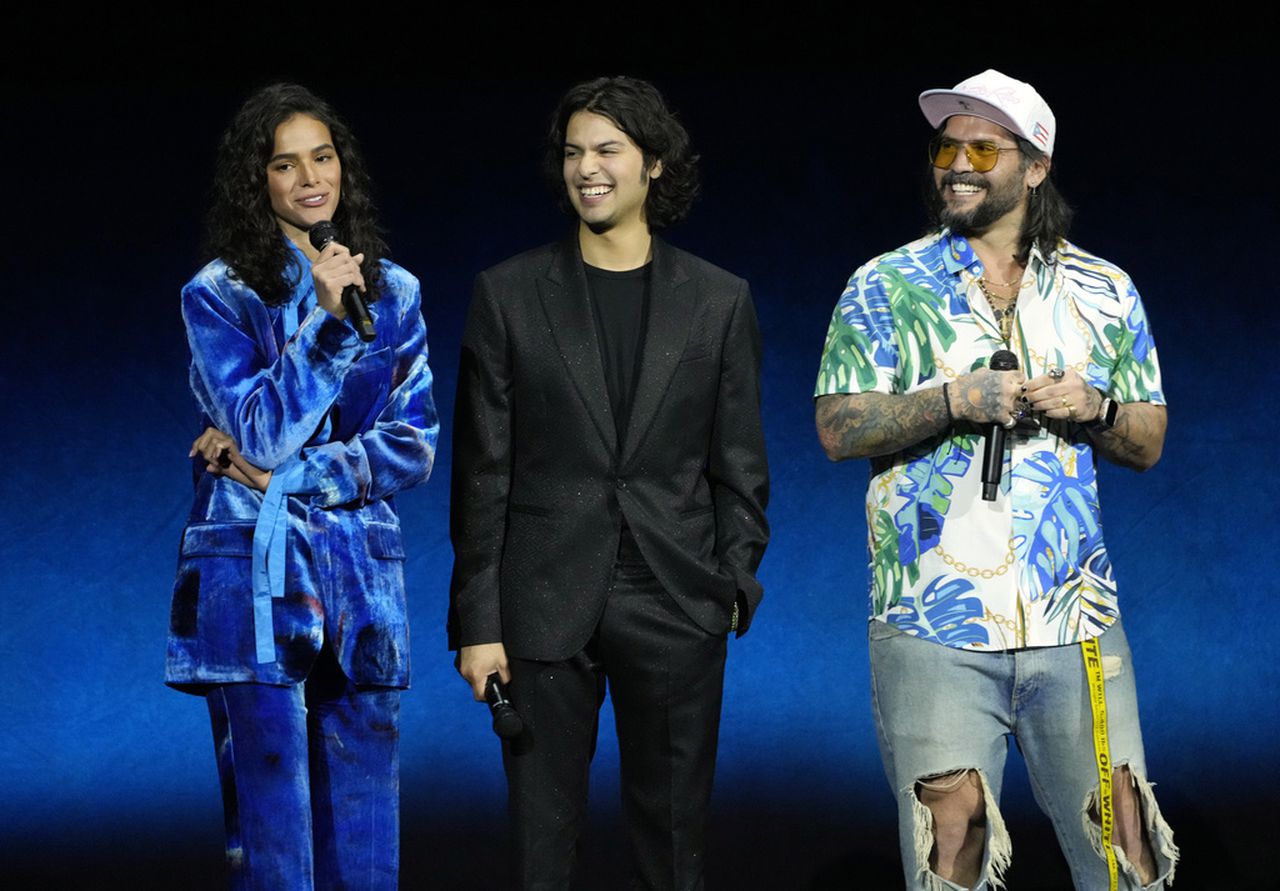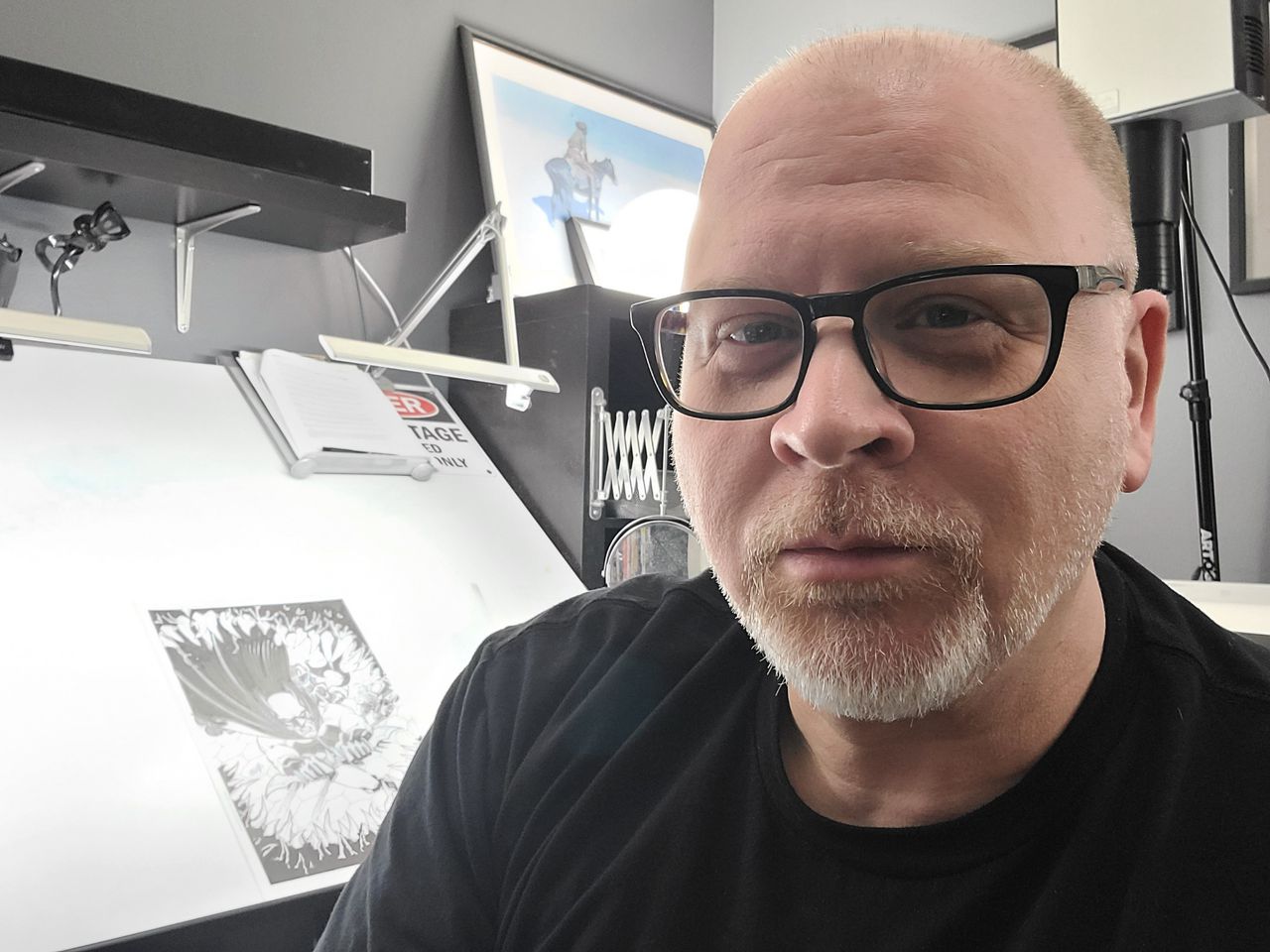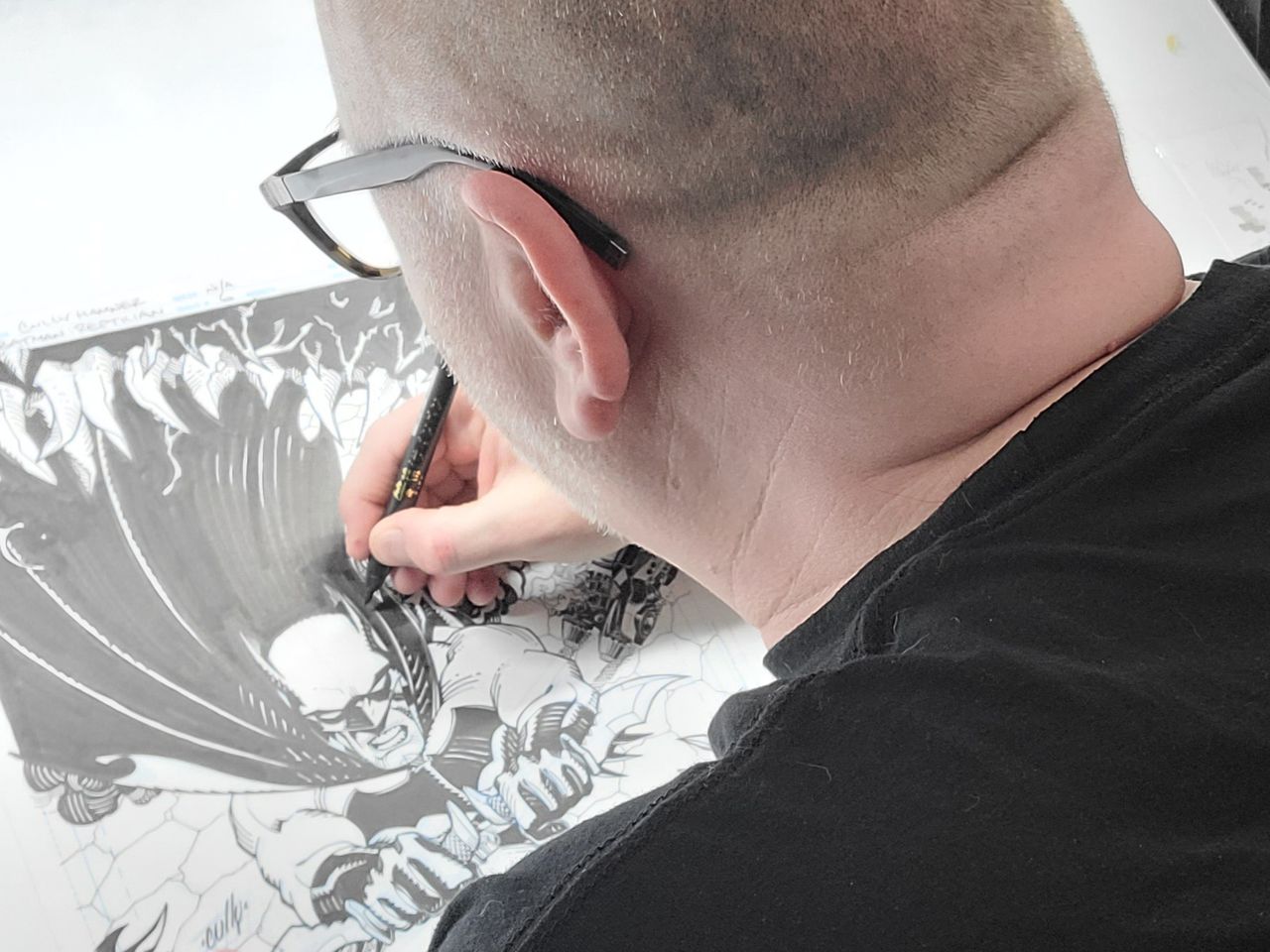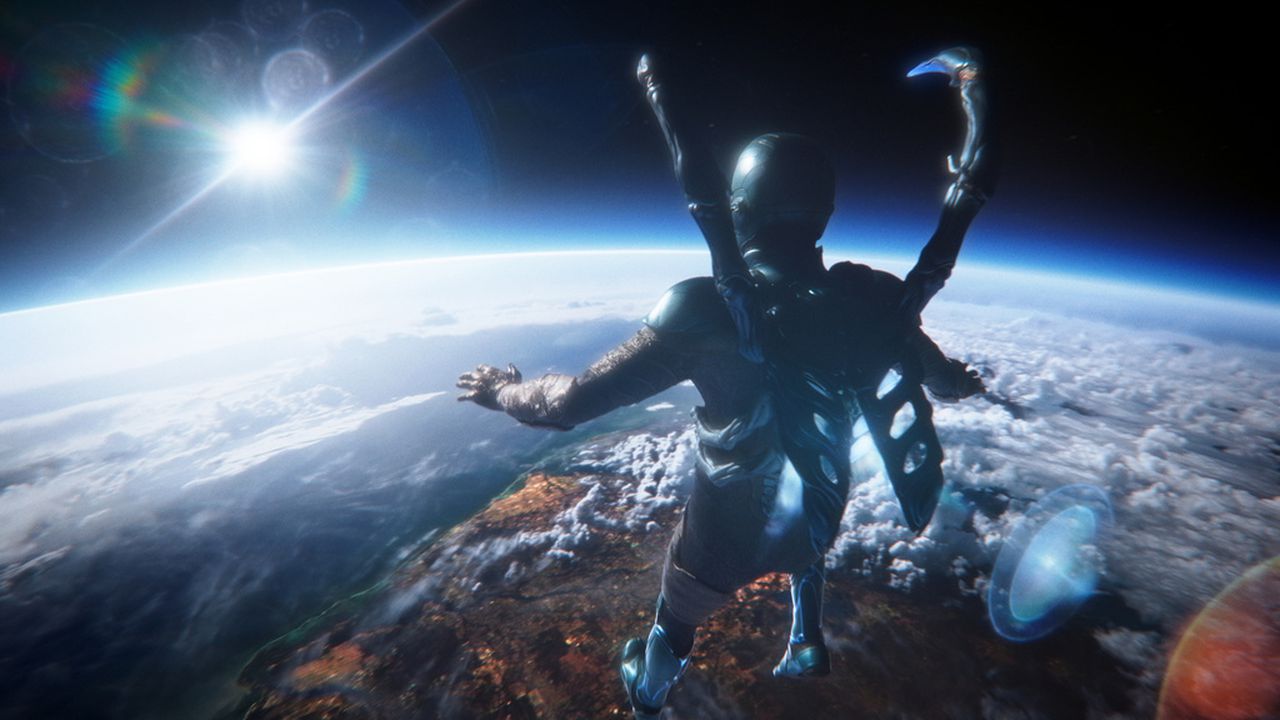âBlue Beetleâ cocreator, Alabama native talks DC Studios film, Bruce Willis
The pronunciation of Jaime Reyes’ first-name really matters. It’s pronounced “hi-me,” and not (as I initially thought) “jay-me.” Reyes is the alter ego of the titular superhero in DC Studios’ new film “Blue Beetle,” which opens in theaters this weekend. Starring Xolo Maridueña of “Cobra Kai” fame and directed by Ángel Manuel Soto, it’s the first major superhero film with significant Latino representation.
The Blue Beetle is a mid-level character created during the 1930s by Charles Nicholas during comic books’ Golden Age. By the end of the 1960s, there’d been a couple different versions of the character, his alter ego, origin story, powers and even publisher.
In 2006, DC Comics wanted to reboot Blue Beetle. They tapped writers John Rogers and Keith Giffen and artist Cully Hamner, a North Alabama native then residing in Atlanta. They updated the character as a Mexican-American teen with a high-tech/high-powered armored suit, obtained through the possession of an extraterrestrial scarab, a beetle-shaped amulet. The character became a member of iconic superhero teams Justice League and Teen Titans.
The “Blue Beetle” film cast also boasts the legendary Susan Sarandon as villain Victoria Kord, Raoul Max Trujillo as baddie Conrad Carapax, comedian George Lopez as Jaime’s uncle Rudy Damián Alcázar as Jaime’s father Alberto.
This image released by Warner Bros. Pictures shows Xolo Maridueña in a scene from “Blue Beetle.” (Warner Bros. Pictures via AP)AP
There’s growing buzz for “Blue Beetle.” The film has an early, 88 percent “fresh” rating on review aggregation website Rotten Tomatoes. Variety predicted during its opening weekend “Blue Beetle” has a real shot at knocking the “Barbie” juggernaut off its number-one box-office rankings. AV Club opined the film could deliver a “surprise win for DC” following recent flops like “The Flash” and “Shazam 2.” Veteran critic Owen Gleiberman hailed the “Blue Beetle” cast’s “vibrant,” “appealing” and “scene stealing” performances, the film not taking itself too seriously overall, and the “old-school rock ‘em sock ‘em” visual effects.

Bruna Marquezine, left, and Xolo Mariduena, center, cast members in the upcoming film “Blue Beetle,” are joined by director Angel Manuel Soto onstage during the Warner Bros. Pictures presentation at CinemaCon 2023, the official convention of the National Association of Theatre Owners (NATO) at Caesars Palace, Tuesday, April 25, 2023, in Las Vegas. (AP Photo/Chris Pizzello)Chris Pizzello/Invision/AP
And with a running time of 127 minutes, “Blue Beetle” is of merciful length, especially compared to some superhero flicks that slog on for two-and-a-half hours or so.
Cully Hamner grew up in Huntsville, where he’d walk a few blocks to a convenience store to buy comics off the spinner rack there. When he was around 13 or so, a local shop called Tattooed Lady Comics became his go-to. Later, Hamner moved to Morgan County and attended Brewer High School.

Comic book artist Cully Hamner. (Courtesy Cully Hamner)
In his early 20s, Hamner left Alabama for Atlanta where he joined up with Gaijin Studios, an alliance of rising freelance artists. During his career, he’s drawn A-list heroes including Batman, Green Lantern, X-Men, Daredevil, Silver Surfer and many others.
He also cocreated “RED,” a 2003 comic-book mini-series later made into a hit action film with Bruce Willis starring as protagonist Frank Moses, a retired CIA agent out for revenge. The “RED” cast also featured Helen Mirren, Morgan Freeman, John Malkovich and Mary-Louise Parker.
On a recent afternoon, Hamner checked in via Zoom video call from his current residence in Austin, Texas, a few days after returning from a screening of “Blue Beetle” on the DC Studios lot in the Los Angeles area. Edited excerpts below.
Cully, what were your first impressions after watching the new “Blue Beetle” film?
My first impression was that they really got the relationships. Also, that it was a lot of fun — it was a lot more fun than I actually thought it was gonna be – and the casting was great. And it was kind of ratifying that my costume works in three dimensions.
Just going by watching the trailer since “Blue Beetle” hasn’t hit theaters yet [as of this interview], but I thought the film looks great but also warmer and more intimate than a lot of superhero movies do.
I did sort of get that. I mean, when I say that they got the relationships, not only did they sort of translate some of the relationships from the comics, but I felt like that really nailed the family dynamic. Like, in a big way. In a way that I think people will really. respond to, especially people who are members of Latino families. I’ve been hearing it from people all over the place, and the audience that I saw with was just on board, you know?
This is the first superhero movie starring a Latino actor in the lead role [and also with a Latino director]. I’m a white guy, so I’ve seen a lot of white guys onscreen in masks and capes and stuff …
Same.
The saying “if you can see it, you can be it” really is important though. Can you talk about being part of this kind of positive and progressive direction with the Latino “Blue Beetle” character you cocreated?
Look, everybody wants to be represented on screen. It’s a power fantasy, and everybody wants to take part in that power fantasy. And it’s hard to do, I think, when cis male whiteness is the default you see on screen.
So, you see something like “Blue Beetle” or “Barbie” or something like that, it’s not just about empowerment, it’s about representation. And it’s about being able to see yourself as part of a mega-culture. All of these subcultures form a mega-culture.
It’s like what we used to see on “Schoolhouse Rock!”, right? The melting pot. That doesn’t mean that the ingredients aren’t recognizable and aren’t there, but we’re all a mass of different cultures. And I think it’s great that we get to see that on screen. That was our intent when we did the comic. We wanted to do a character that people could get behind and see it’s universal, but also see the specificity of themselves.
We’ll see Jaime’s origin story onscreen. But I want to know about the real origin story, how you guys came up with that character back in the mid-2000s.
Well, it’s funny, because we’re talking about probably around 2005 or 2006. I’ll even go back a little further. My career at that point was kind of at an ebb in my opinion, like I was not sure if I wanted to stay in comics and I wasn’t sure if there was a place for me, really. And Dan DiDo — who had recently taken a job as vice president at DC and started taking over editorial — came up to me and introduced himself at a convention. I think it was Baltimore Comic Con if I’m not mistaken.
He said, “Hey, I really like your work and I want to keep you around,” which was a big thing to me, because I sort of felt like I was out of favor at DC. But you know, as happens, a new regime comes in and they decide they want to shake things up. So, it wasn’t too long after that, that I got a call from Mark Chiarello, who was the art director in DC at the time, asking me if I wanted to help design a new Blue Beetle. And at that point, look, I liked the Ted Kord “Blue Beetle” fine I was a fan of like the [Keith] Giffen, [J.M.] DeMatteis, [Kevin Maguire] “Justice League” comics,” so I knew the character.
I didn’t quite understand at first that they wanted to new character to have the name Blue Beetle, but they didn’t really necessarily want to have any connection to the previous versions of the character. They had a script already that John Rogers and Keith Giffen had written. Mostly it was on the page, as far as the dynamics of the family and who Jaime was and who his friends were. But they just didn’t know how the character looked. I had some sort of vague direction that they wanted the character to have sort of an armor like appearance or a technological kind of event, because he got his suit that he wears from this alien scarab, right?
But they had a couple of other artists who passes on it, and it seemed to me that they were directed towards doing sort of a Japanese robot, kind of a kaiju kind of look, which I thought, “That doesn’t make a whole lot of sense to me.” You have to keep the humanity in the character — not just in the way he’s written, but the way he looks. He’s got to look like a person. And no one’s gonna want to draw a robot, like a complicated robot, every month in a comic book. You can’t make your deadlines that way. So, I steered it back towards a more kind of the superhero aspect of it.
I wanted to keep more of a human shape. Silhouette is very important to me when designing a character. And I wanted to lean into the beetle-ness of it, because the character’s name is Blue Beetle but there’s mothing beetle-ish about this outfit at all. But I also wanted to lean into his culture. It was very specific, how his family and his culture was depicted in the script. Also, it was sent in El Paso, which as you know, is right on the border. The Mexican presence is El Paso is heavy. It permeates the entire city, that entire area.
Also, looked at a lot of pictures of beetles, and the thing that struck me was the kind of pincer thing that you see. I wanted him to have that to give him that recognizable silhouette. And my idea was to make it sort of a backpack. If you look at my original designs, which you can find online, you’ll see that I’ve written on there “bug pack,” because that’s what my name for it when I was designing this thing. I basically wanted to look like a beetle is kind of holding onto his back. And you had these pincers and have arcs of electricity or whatever that, you know, jump between them and everything. It’s kind of a cool, distinctive effect.
But also with the suit’s face, I wanted to give it sort of a luchador [Mexican pro wrestling mask] motif to it, which gave it a hint of connection to Mexican culture in our kind of superhero a kind of way.
So that’s what we ended up with. The design that I handed in, is almost probably 99 percent the design that you see in the comics today. The only note that the art director had was to add some sort of graphic to his chest. And I added that to basically kind of give at least some connection to the other Blue Beetles.
The cool thing about it was that Dan became a really good friend of mine, was a real supporter of mine, all of his tenure at DC. He had said on his Facebook page when he talked about this specific subject, that I had drawn things and ideas for powers into the designs that I did that the writers later picked up on and started incorporating into their own scripts. So there really was kind of a give and take, and a mutual sense of creation, I think, between John, Keith and I that really kind of carried forward.
As far as just designing the characters, I’ve just tried to design people who are universal. Jaime’s mother was a nurse. My mom was a nurse. His best friend Paco was based on my roommate at the time, who, in a funny story ended up working on the film as a specialty costumer. There are pictures of him that were online of them shooting of him standing next to Jaime [as portrayed by Maridueña]. I’m like, “Wow. There’s the guy I drew in the comics standing next to a guy who looks like the guy, the character, in the comic.
Xolo’s resemblance to your original drawing of Jaime Reyes is nuts.
It’s nuts. What funny about that is, there was an entertainment reporter, I remember him telling me he was hearing that there was a real effort to do a Jaime movie. And I remember saying, “They gotta get that kid from ‘Cobra Kai.’ He’s perfect.” And lo and behold, that was exactly what was in Ángel’s, the director’s, mind and he hired him for the movie, and the rest is history.
I always thought he was so good on “Cobra Kai.”
Yeah, I love that show.
I watched an interview [from before the ongoing actors’ strike] with Xolo Maridueña, where he namechecks you. He really knew his history of the Blue Beetle character, which I know is part of the big, but still he put in the effort. Can you talk about Xolo’s performance in the move movie?
Well, first off, I will say I get the impression that he respected the character enough to read it. He didn’t just look at video games, and just look at the cartoons. I can’t say for sure but that’s my impression, that he and Ángel both really dug into the comics. And I think he saw himself there. I think he saw why he was hired to play that part. I’ve never met him — I have met the director – but hopefully at some point. Obviously, he can’t promote the film due the strike.
The performance I saw, a little over a week ago, was spot on. He was the character. He had that optimism. He had that love for his family. That “why is this happening to me?” thing. This sort of body horror thing that happens, which is straight from the comic, the scarab grafting itself to spine, all that stuff.
But at the same time, stepping up and taking responsibility for this newfound role that he has. He led the movie. He carried it. I mean, that all the other actors that are in it are great, but they form a layer around him.
You’re no stranger to blockbuster film adaptations of your work, with the star-studded and highly entertaining 2010 hit “RED” and its sequel. Earlier this year, Bruce Willis’ family revealed his diagnosis [of frontotemporal dementia, which led to Willis retiring from acting]. You’ve told me some cool Bruce Willis stories before, from you visiting the “Red” film set. Do you have any other fond memories of Bruce, an actor whose work so many of us have enjoyed?
My experience with him, it’s not like we’re buddies or friends or anything, but he was very kind and respectful to me when I visited the set. And then we did a little bit of press here and there together, at the premieres that sort of thing. He always seemed to remember me, which I always thought was really nice because he’s probably got a hundred people in his face every day.
We always just seemed like a good dude. I’ve told you all sorts of anecdotes here and there, but one that strikes me is I remember coming out of the first premiere at the [Grauman’s] Chinese Theatre [in Hollywood], and it was a huge crowd and I see him like 50 feet away. And I remember him locking eyes with me and just put his hand in the air and started walking towards me and then he just kind of brought it down into handshake. And he’s like, “What did you think?” and we spent some time talking about it [the film] and then we went to a party, the premiere party. It was just a nice thing for him to do. I mean, he could have just walked the other way. You know, I certainly didn’t expect any sort of treatment like he knew me or anything like that.

Comic book artist Cully Hamner. (Courtesy Cully Hamner)
What’s next for you as a comic book artist and creator?
Right now, I’m doing a book, a creator owned series with [accomplished comic book writer and best-selling author] Greg Rucka for Image [Comics]. I’m not going to make an announcement as to the title or anything like that yet, because I think they’re going to be rolling out an announcement at some point. But that’s what I’m working on right now.
Greg is someone I did [DC character] “The Question” with and we’ve worked really well together on some other things. And this is a thing that we’re doing that has got a real commentary on society to it, but it’s also just balls-out action. If you liked our “Question” work, you’re gonna like this.
And I’m still doing a lot of covers for Marvel and DC and Boom and all these other kinds of companies. I’m sure that once I’m finished with this series that I’m doing, I’ll probably turn right around and do something at one the big two again. It just depends.

A variant cover image by Cully Hamner for DC Black Label comic-book series “Batman: Reptilian.” (Courtesy Cully Hamner)
As someone whose done work for both DC and Marvel, what do you think is the biggest difference between those two big comic book universes?
When I was growing up, when I was small, DC was a simpler world than the Marvel world. The Marvel Universe was a lot more reflective of kind of the problems of today, and, you know, people bickering and arguing and living with differences. Whereas the DC world when I was growing up, was a little safer. You had these sort of godlike characters that were kind of taking care of you.
Now, I will say that I feel like the barrier between what is distinctly Marvel and what is distinctly DC is probably a lot thinner than it used to be. Obviously, comics have evolved. A lot of the Marvel approach has bled into DC, so you have characters that have, you know, real world problems and foibles, that sort of thing. And I think that you have Marvel characters that are treated a little more godlike than they used to be.
But really for me it’s still a sense of these characters that are looking out for you. You know, Superman looks out for you, Wonder Woman looks out for you, Batman looks – and that to me is a big trademark of DC Comics.
